Did you know that your Great Dane may be missing out on important nutrition that could reduce their risk of experiencing bloat? If you are looking for the best nutrition to prevent bloat in dogs, this post is it. We’re looking at the actual science and research to help ensure that you and your Great Dane are happy, healthy, and stress-free!
There are two things your Great Dane needs in their diet if you want to reduce their chance of GDV Bloat.
Bloat is the #1 killer of Great Danes.
It can happen suddenly when you least expect it. Bloat in giant breed dogs is painful, traumatic, and often results in death.
Let’s dig in…
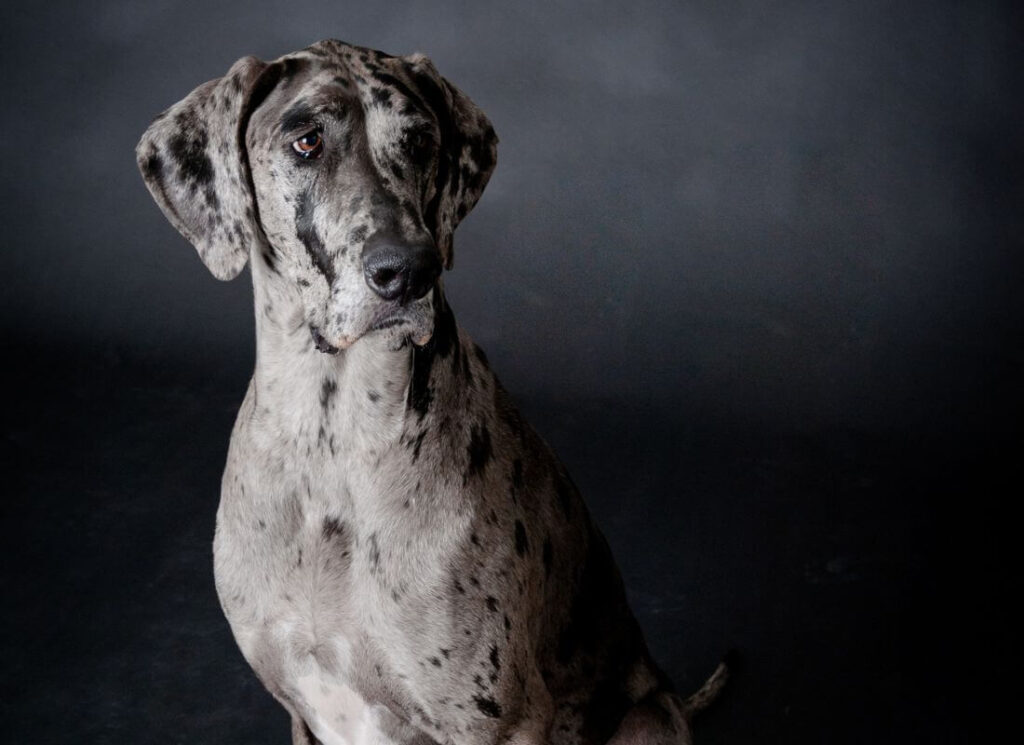
What is Bloat in Dogs?
First, you have to understand what bloat is. I’ll keep this short.
Bloat is when the stomach fills up with gas, fluid, or air. Left untreated, the stomach can then flip over on itself. This is called torsion. Torsion is deadly.
37% of Great Danes might experience bloat in their lifetime.
Pro Plan Great Dane Update
How to prevent torsion with gastropexy: everything you need to know →
How do I know if my Great Dane has bloat?
RUN, don’t walk, to your nearest emergency veterinarian if you see any of these signs of bloat in your dog:
- Bloated stomach
- Distress including pacing, crying, whining, head hanging
- Foaming at the mouth or excessive drool
- Attempting to vomit (but may be unable to)
- Collapse

Two Things Your Great Dane Needs in Their Diet to Prevent Bloat
I mentioned there were two things you can add to your Great Danes’ diet right now to reduce their risk of experiencing bloat. Here they are:
- A kibble with meat meal or meat by-product meal as a primary ingredient
- Canned or fresh foods
I’m going to dig into BOTH of these in depth below, but here is the scientific study I am referencing:
“Conversely, feeding a dry food containing a rendered meat-and-bone meal decreased risk by 53 percent in comparison with the overall risk for the dogs in the study. Mixing table food or canned food into dry food also decreased the risk of bloat.
During the past 30 years there has been a 1,500 percent increase in the incidence of bloat, and this has coincided with the increased feeding of dry dog foods.“
Read more about bloat research HERE →
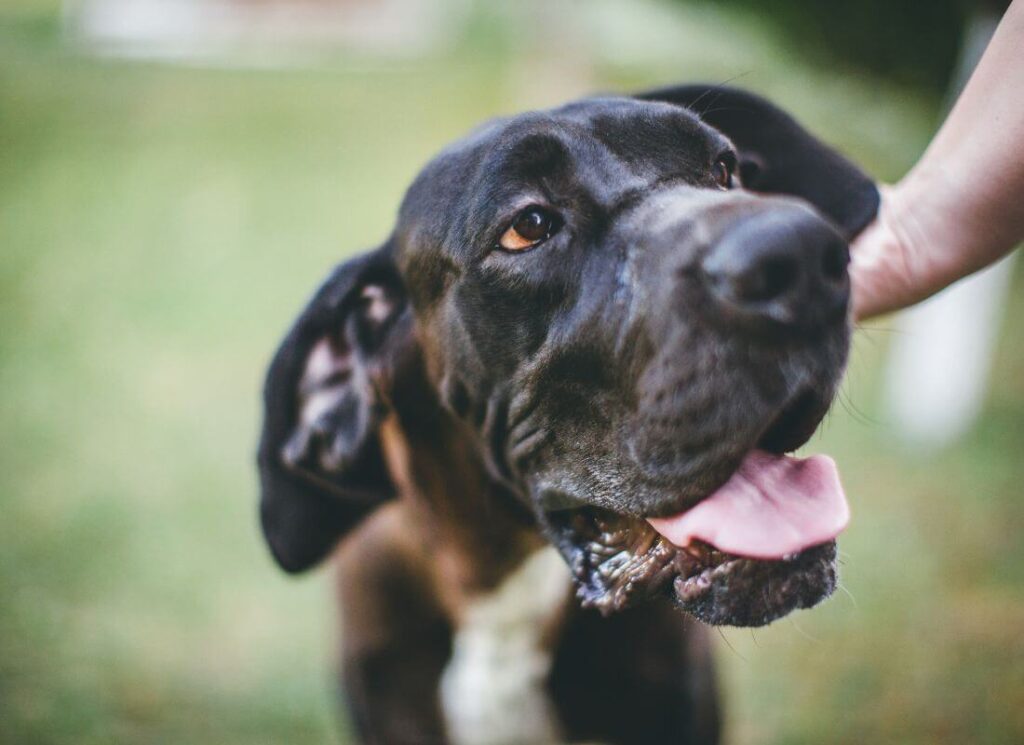
Is Meat Meal Bad in Kibble?
Meat meal and meat by-product meal are GOOD in kibble! Reduced bloat risk aside, let’s talk a bit more about why.
Fresh meat or fresh deboned meats (not meat meals, in other words) are 70% water. This makes them heavy before cooking, so they show up on top of the ingredients list, but not after.
Just imagine what happens to fresh meat when it’s extruded into kibble! Only 30% of it will be left, even if your kibble brand says ‘meat is the first ingredient‘.
Yikes!
Meat meal and meat by-product meals are rendered and dehydrated before they go into the kibble. At just 10% water, that means your kibble will contain a LOT more actual meat and meat-based nutrition!
Not only that, but unlike fresh meat, meat meals (including those made with by-products) contain organ meat, cartilage, bone, and skin which are highly nutritious and species-appropriate.
No wonder meat meals reduce the risk of bloat!
If your kibble brand is mostly ‘fresh meat’, it’s time to find something better.
What dog food brands reduce the risk of bloat?
While no correlation between specific dog food brands has ever been made when it comes to bloat in Great Danes, the information we’ve learned about meat meals can certainly help point us in the right direction.
We are a science-backed blog, so our nutrition recommendations will be coming from the top canine nutritionists in the country. (Read more about board-certified Veterinary Nutritionists HERE).
The following dog food brands are balanced for Great Danes and contain rendered meat and bone meal as a primary ingredient.
(FYI, Great Dane puppies should have puppy food until 18-24 months. Don’t believe us? Read here for more).
- Purina Pro Plan Large Breed Puppy – any flavor!
- Purina Pro Plan Sensitive Skin & Stomach Large Breed puppy – TOP PICK, salmon-based
- Eukanuba Large Breed Puppy (Great for active and sporting dogs)
- Purina One Large Breed Puppy (Excellent budget option)
- Hill’s Science Diet Puppy Large Breed
- Royal Canin Giant Puppy Dry Dog food (to age 12 months) – TOP PICK, PREMIUM OPTION
- Royal Canin Giant Junior Dry Dog food (8-24 months)
- Purina Large Breed Puppy Chow
Check out THE GIANT DOG FOOD PROJECT to compare brands and values.
- Purina Pro Plan Sensitive Skin and Stomach Large Breed (Salmon based, chicken free)
- Purina Pro Plan Large Breed Shredded Chicken & Rice (Large Pieces & Chicken Shreds!)
- Purina Pro Plan Large Breed Weight Management (Get the weight off)
- Purina Pro Plan Large Breed Bright Mind Age 7+ (for Senior Great Danes)
- Purina Pro Plan Giant Breed (Hard to find, might be discontinued)
- Royal Canin Giant Breed (Amazing for dogs with chronic loose stools, TOP TIER)
- Eukanuba Large Breed (Great for active and sport dogs)
- Purina One Smart Blend Large Breed (Fantastic budget-friendly option)
- Hill’s Science Diet Large Breed Beef & Rice
- Purina Pro Plan 30/20 Sport Beef & Bison
What is Ingredient Splitting in Dog Food?
What are the best foods for Great Danes?
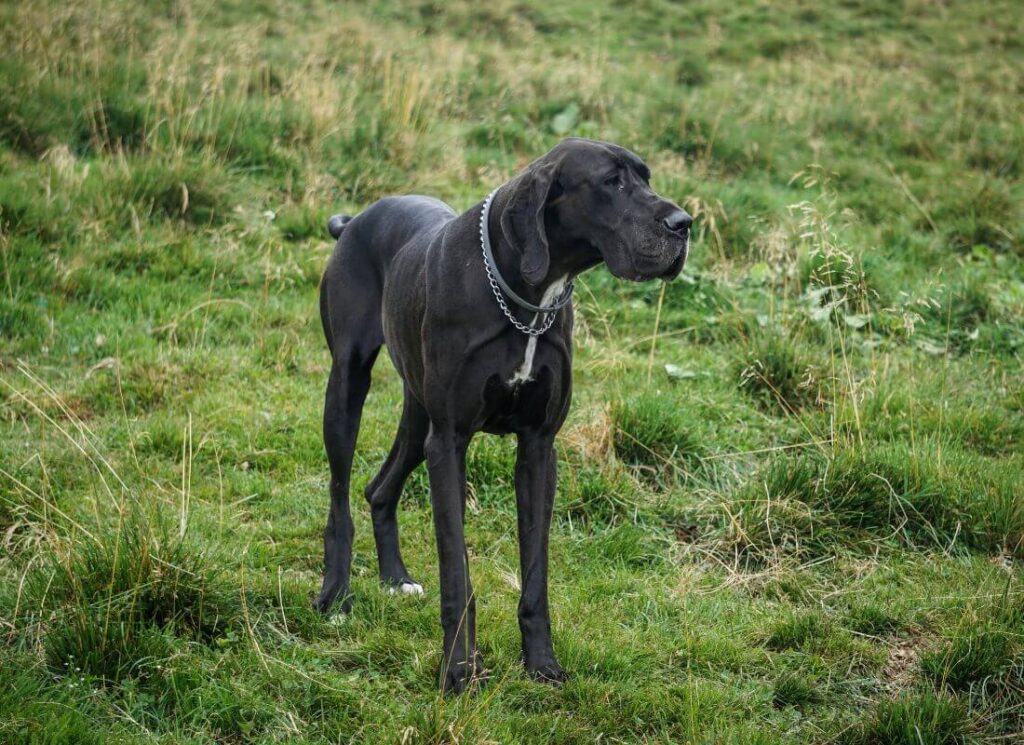
Canned, Fresh, & Raw Foods for Great Danes
The second important thing mentioned in the Tufts University Bloat Study was that canned or fresh foods may reduce the risk of bloat!
What does this mean? Your dog gets a TASTY topper on their food, and you can feel good knowing that you are not just feeding a dry kibble (which is correlated with an increased risk of bloat).
You don’t need expensive, fancy ‘toppers’ from the natural pet food store. As a matter of fact, most of those are, expensive, unbalanced and a waste of money. We have much better ideas for this, including helpful links below!
Here are some important things to keep in mind:
- For Great Dane puppies under 18 months, be VERY careful. Keep toppers to less than 5-10% of the diet and do not allow overeating.
- When choosing unbalanced toppers of any kind, including table scraps, meat, goat milk, eggs, treats, or incomplete raw blends, they must be less than 5% of the overall intake.
- Encourage SLOW eating! Toppers may be fun and enticing, but fast eating increases bloat risk. Use puzzle feeders (like this one on Amazon) to slow your pup down.
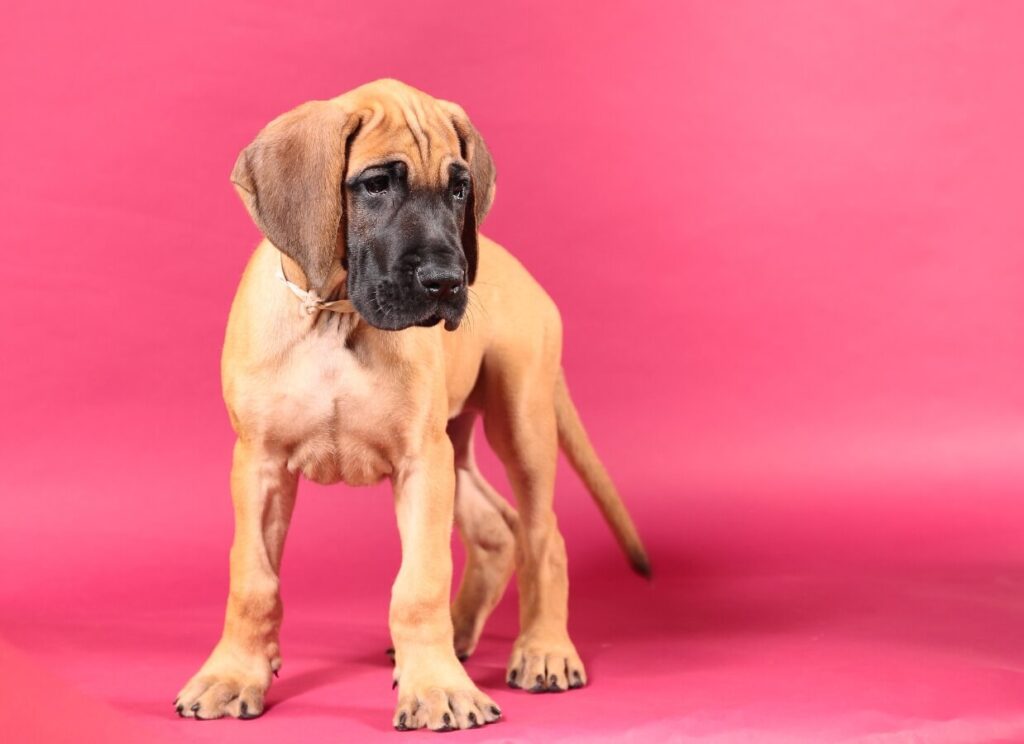
The Best Canned Foods for Great Danes
I personally use and love Purina ONE canned food, because it’s economical and full of meat! Depending on your budget, you can offer a spoonful or an entire can. Anything is likely to be better than nothing!
Table Scraps & Treats
Another option is to offer table scraps and treats. These are not balanced, but they are a fun easy way to add variety to your dog’s diet.
Keep table scraps and treats to a minimum to avoid digestive upset and nutritional deficiencies. Here are some ideas:
- Scrambled egg (never daily. Too many eggs can cause a biotin deficiency)
- Blueberries, bananas, or apple
- Spinach, green beans, or squash (pro tip: run these through a food processor so they are more digestible!)
- Meat with no seasoning
- Organ meat
- Homemade dog treats, like these dog pumpkin pies
- A scoop of canned pumpkin
- Olewo Carrots (which also help with loose stools)
Never feed cooked bones, weight-bearing bones, grapes, chocolate, garlic, onion, or anything that contains xylitol or birch sugar.
Raw Food to Reduce Bloat Risk
Another acceptable option for topping your dog’s food is a raw blend.
An acceptable blend will have meat, bone, and organ in it.
Raw does come with a higher risk of exposure to salmonella or eColi, so please use good hygiene practices here.
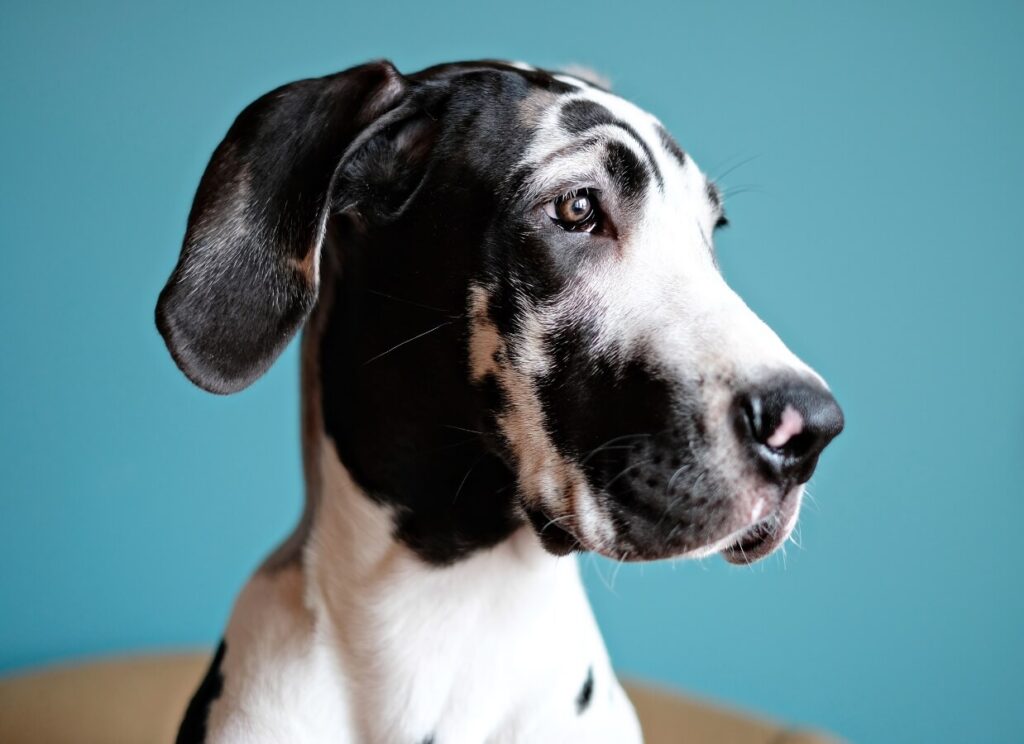
How to Prevent Bloat in Great Danes
Unfortunately, there are no proven ways to prevent bloat.
We can, however, reduce or increase risk based on what we currently know from research.
Bloat is primarily a genetic disease, so choosing thoughtful breeders is one step in the right direction.
Socializing your Great Dane and using modern, stress-free training methods can help, too. Being fearful or aggressive increases bloat risk, and is actually not normal for Great Danes.
Address poor gut health, nutritional deficiencies, and the gut microbiome by choosing a quality well-formulated diet and sticking with it. Poor gut health is a major risk factor for bloat.
Add a probiotic if your dog is struggling with chronic gas.
Make sure your Great Dane eats slowly and is offered multiple small meals each day. Resting before and after meals does very little to prevent bloat or reduce risk. Find a balance between healthy play and being sedentary.

Leave a Reply